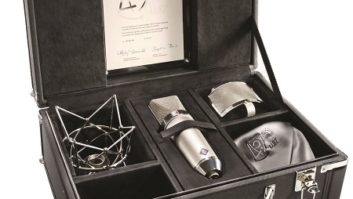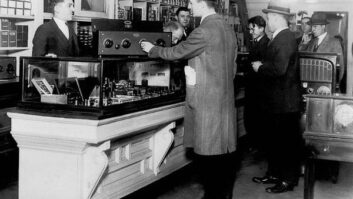I had to laugh at one of the numerous suggestions that continue to arrive about the picture we published in an earlier column.

Fig. 1: Put a professional labeler to work around your station. One reader suggests that maybe the device is a new “10 dB increase” mod to boost HD Radio power!
We explained in the Dec. 17 issue that it actually is a poor man’s power failure detector. Interestingly, we learn that the rig also was used by radio amateurs and folks in the radio paging business. Plugged into an outlet, the relay would trigger an alarm panel when power failed.
Craig Baker of WKVQ(AM)/WYTH(AM) in Georgia writes that he’s seen so many of these devices over the years, they ought to have a part number! He inherited two when he purchased a station. Here’s a twist: Craig saw one in use plugged into a hardware store light timer, being used to control the power cutback of an AM station from 1 kW to 250 W.
Alan Shea of the HCJB Technology Center added that the relay is energized until the power fails — or someone pulls out the plug, which I could really relate to. Years ago I got a trouble call from an automated station that was losing its satellite feed every evening about 7 p.m. The feed would reappear mysteriously after about 10 minutes. You guessed it: The cleaning folks were pulling the plug to the satellite receiver to plug in the vacuum.

Fig. 2: Labels on containers helps you spot parts quickly. Paul Black of PointBlank Services Co. of Pleasant Hill, Calif., says that in addition to a power loss indicator, this relay could be used as a generator “run” status for a remote control. Plugged into the AC power feeding the tower lights, it could signal a tower light power failure.
WA3VJB, Paul Courson, initially thought the picture showed a variation on an engineering gag he saw handed to a rookie technician years ago, an AC line cord terminated in an XLR. The tech was told to never lose the cable — in case there was a power failure!
That’s as bad as coiling a two-foot length of bus wire around a core of solder.
* * *
Did you get a labeler for the holidays? If not, treat yourself to the after-holiday sales and pick one up. You’ll find plenty of uses, as seen in Fig. 1. If you’re looking for a quick way to get organized, these personal labeling machines work well on parts containers (Fig. 2) and to identify power plugs in a rack (Fig. 3).
You probably have found other uses. Drop me a line; if you have one, attach a high-resolution photo. E-mail to [email protected].

Fig. 3: Don’t pull the wrong plug. Label it! * * *
Broadcast consultant Alan Kirschner, principal of Kirschner Broadcast Services, writes that there are quite a few brands of “egg crate” sound proofing foam that are listed as not being flammable. You can find these by Googling “foam sound proofing.”
In fact, he adds, many cities require the use of flame-retardant materials on walls. Beware of using carpet; most is not flame-retardant and will not pass the vertical flammability tests.
Not only could carpet violate local building codes, he reminds us, but the installation of anything flammable on the walls could void insurance coverage should there ever be a fire. Thanks, Al, for sharing some things
* * *
Bob Culver of the PE firm Lohnes and Culver adds to Al’s comments, writing that acoustical foam intended for wide-area application on walls and overhead must be “fire proof.” It is not so much that the material will not burn, but it does not propagate fire quickly like normal polyurethane foam.
Bob’s recommendation is Sonex, www.sonex-online.com. Not cheap, but it won’t burn.
John Bisset has worked as a chief engineer and contract engineer for 40 years He recently joined Nautel as regional sales manager for Europe and Southern Africa. In 2007 he received the SBE’s Educator of the Year Award. Reach him at [email protected]. Faxed submissions can be sent to (603) 472-4944.
Submissions for this column are encouraged and qualify for SBE recertification credit.












